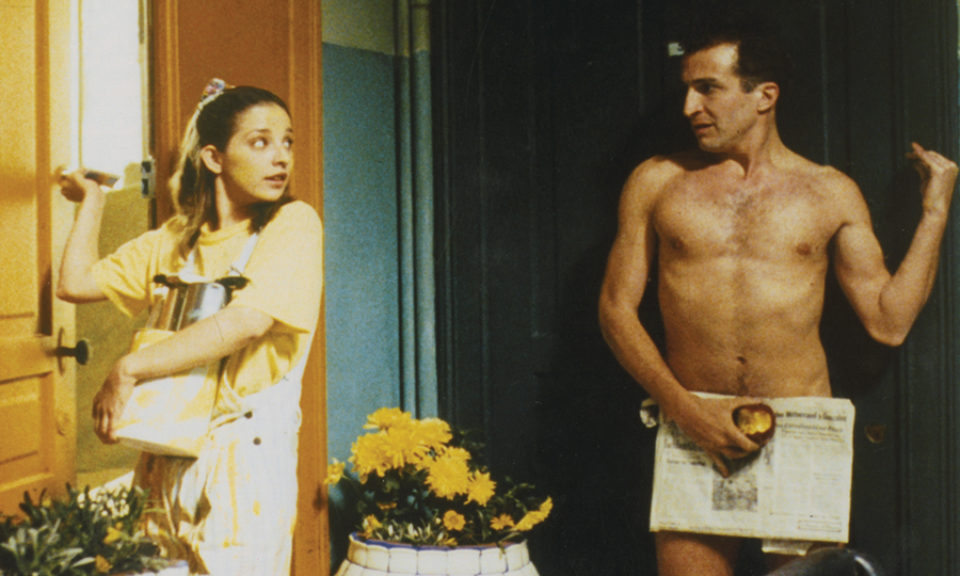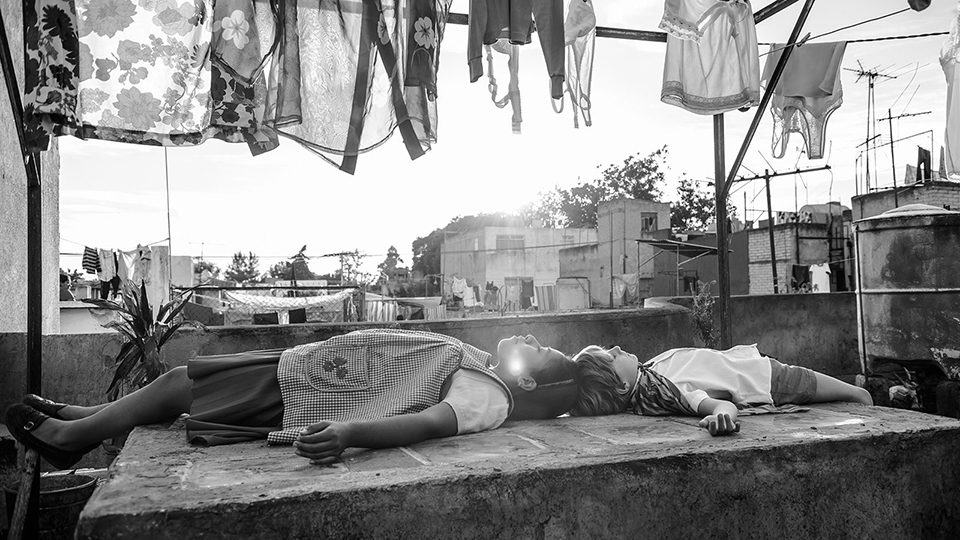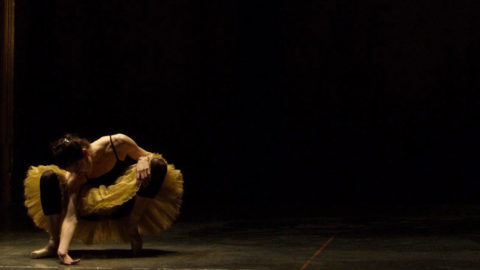By José Teodoro in the September-October 2018 Issue

The Turning of the Earth
Alfonso Cuarón’s richly realized ROMA surrounds us with the bourgeois Mexico City of his youth, seen through the eyes of another
The opening scenes of Roma, Alfonso Cuarón’s first Mexican film in 17 years, draw us into a spell of domestic labor. The washing of patio tiles—which will find an eloquent rhyme in the tidal roar of the film’s climax—possesses a lulling lyricism that feels strikingly distant from the abrupt, ribald openings of Cuarón’s previous Mexican films, Sólo con tu pareja (1991) and Y tu mamá también (2001). ROMA’s protagonist, to whom these opening scenes function as a kind of ode, also represents a radical departure from her predecessors in terms of gender, class, race, temperament, and social stature. ROMA is closer to autobiography than anything Cuarón has made—the dreamy little boy who recalls a past life as a sailor would appear to be the director’s nearest surrogate in the film—yet the figure at its center is the farthest from his life experience. Octavio Paz once wrote that the “history of Mexico is the history of a man seeking his parentage, his origins.” Among the most remarkable things about Cuarón’s most personal film is that it locates his parentage in the story of Cleo, an indigenous woman inspired by the women who looked after his childhood home and helped raise him.

From the September-October 2018 Issue
Also in this issue
Of the eight features Cuarón has directed over the last three decades, only three have been Mexican. While evenly spaced across his filmography, these Mexican films feel like a separate body of work; unlike Guillermo del Toro or Alejandro González Iñárritu, the contemporaries with whom he’s most associated, Cuarón, who resides in London, seems to regard other industrial or national contexts as opportunities to explore a disparate set of concerns and interests. Taken broadly, the Mexican stories are less driven by urgency, suspense, and compression than are, say, Harry Potter and the Prisoner of Azkaban (2004), Children of Men (2006), or Gravity (2013); instead, they tend toward an expansive, past-tense, novelistic sense of time, an element that in Cuarón’s English-language U.S./U.K. productions only fully emerges in Great Expectations (1998), which is, not incidentally, based on a novel. Unfolding over the course of 1970 and 1971, ROMA makes a span of time into almost as central a character as its heroine or her city.
More obviously, Cuarón’s Mexican films are fundamentally concerned with sex, featuring plots that revolve around sexual acts and their existential fallout. Sex is a fountain of humor, arousal, character development, and visual pleasure; it’s also a means of critiquing social mores, such as Mexico’s particular strain of machismo. In each case the Mexican films reverse the cinematic paradigm of female display and male gaze by highlighting men in erotic performance: Tomás Tomás in Sólo con tu pareja, naked save a pair of green All-Stars, gleefully making his daily dash down his apartment building’s spiral staircase to retrieve his morning newspaper; Y tu mamá también’s Tenoch and Julio beating off on parallel diving boards, egging each other on until their simultaneous orgasms propel blobs of semen into an absurdly fetishized chlorinated descent; and in his latest, Fermín, with utmost seriousness, executing a fully nude, postcoital martial arts routine with a shower curtain rod in a rented room.

Sólo con tu pareja. Courtesy of The Criterion Collection
What’s only fully apparent with the arrival of ROMA is that this oeuvre within an oeuvre also tracks the development of a lifelong reckoning with disparities of privilege in Mexico, those deterministic social factors that Cuarón, whose father was a nuclear physicist, was sheltered from the brunt of by virtue of his middle-class upbringing. To move from film to film is to witness the maturation of a filmmaker’s social consciousness. The impact of this maturation on the work is profoundly affecting.
Inspired by the films of Ernst Lubitsch and Blake Edwards, Sólo con tu pareja, written by the director’s brother, Carlos Cuarón, is a boudoir farce about a ladies’ man who learns to love prophylactics—a lesson that ROMA’s Fermín would do well to learn. The title refers to a national PSA campaign suggesting the surest method of evading AIDS is to have sex “only with your partner.” Yet in 1991, Mexican culture—like numerous other cultures—still perpetuated the notion of AIDS as a disease that only threatened homosexuals. What’s more, along with driving recklessly or eating intestine-scalding spicy food, accumulating sexual conquests has long been a cornerstone of Mexican masculinity. Thus the decision to address the AIDS epidemic through the story of a condom-eschewing Don Juan proves germane, mocking dunderheaded claims of heterosexual immunity and focusing the film’s satirical aim on a worthy target.
Nimbly embodied by Daniel Giménez Cacho, adman Tomás Tomás is a decidedly modern, urban, professional, middle-class variation on the Mexican lady-killer, and a type the young Cuarón, working in television in the ’80s, likely would have known well. An especially memorable image finds Tomás squashing underfoot long lines of conical paper cups: one for every woman he’s bedded. Tomás’s powers of seduction seem to stem from the same skill he applies to advertising: he’s witty. While having his blood taken by an attractive nurse, he dismisses the possibility of his contracting HIV with a quip: “AIDS and I have a bilateral non-aggression pact.” Tomás’s looming crisis, however, is signaled by his sudden imaginative impotence. He racks his brain to concoct a novel method of peddling Gómez Home-Style Jalapeños, one of several signifiers of an anxiety connected to Mexican cultural stereotypes—a number of which show up in a nightmare sequence set on a plane, where Tomás’s fellow passengers include a conquistador, an Aztec in full folkloric regalia, and lucha libre legend El Santo.
The real engine of change for our hero is twofold, the first being a vengeful practical joke: the jilted nurse who takes Tomás’s blood and falsifies his results to make it look as though he’s tested positive for HIV. (The fact that Tomás doesn’t have HIV notably contrasts with ROMA, where negligence yields weightier consequences.) Up to this point, Tomás finds exhilaration in any sort of erotic risk-taking, such as banging a bride in the bushes on her wedding day or walking along the ledge of his building in nothing but a towel. It’s during one of these transits that he first notices Clarisa (Claudia Ramírez), a pretty flight attendant and the other agent of change. Tomás spies her rehearsing a safety demonstration and it’s love at first sight—a death knell to the lothario. In fact, after the double whammy of his test results and a humiliating episode with Clarisa, a hysterical Tomás plans to suicide using a microwave—again, what a contrast to the moment in ROMA when the ever-toiling Cleo casually says she wouldn’t mind being dead, simply as a chance to rest. Of course, we needn’t fear for Tomás: Sólo con tu pareja adheres to genre conventions and promises a happy resolution. What makes the film enduring, even audacious, are its details: its burlesque on Mexico’s bourgeoisie, its inventive exploration of cultural clichés, and its highly unusual embrace of chilango colloquialisms—an element enhanced further in Cuarón’s next Mexican film.

Y tu mamá también. Photo: Anhelo Prod/IFC/Kobal/REX/Shutterstock
As with Sólo con tu pareja, the inaugural spectacle of Y tu mamá también, written by both Alfonso and Carlos Cuarón, features two bodies in the throes of copulation. In this case the bodies are those of teenagers; above them hangs a poster for Harold and Maude, a dash of foreshadowing, even if the difference in ages among the film’s central ménage à trois is only a fraction of that between Hal Ashby’s titular twosome. Summer has come and, in the heat of humping, Tenoch (Diego Luna) and his girlfriend make impassioned promises not to cheat on each other while she holidays in Italy—promises we suspect at least one party will break. In the midst of this exchange the soundtrack abruptly cuts out and we hear the voice of the narrator (Daniel Giménez Cacho), a character never seen or identified yet whose role is essential to the film’s scope and poignancy. The obvious precedent for Y tu mamá también’s particular breed of voiceover—along with other key narrative and thematic elements—is Jules and Jim, one of many ardent cinephilic references in Cuarón’s work, the most recent being ROMA’s nod to The Rules of the Game in its holiday hunting interlude. But I would argue that the Cuarón brothers’ deployment of this particular device serves an even more vital purpose than it did for Truffaut’s seminal achievement.
Tenoch and Julio (Gael García Bernal) are best buddies, the former affluent, the latter lower-middle-class. Both are sex-obsessed, and at the precipice between endearing adolescent and obnoxious young man. They meet Tenoch’s cousin-by-marriage Luisa (Maribel Verdú), a Madrid dental assistant relocating to Mexico to accommodate her husband’s new academic post. When Luisa says she’d love to visit a remote beach, the boys entice her with an invitation to a paradisiacal playa called Boca del Cielo, or Heaven’s Mouth. The place is a fabrication—the name inspired no doubt by a shared predilection for fellatio—but when some devastating personal news prompts Luisa to take Tenoch and Julio up on their offer, the boys borrow a car, pick up Luisa, and head down to the coast of Oaxaca. Tenoch and Julio are eager to seduce the roughly dozen-years-older and significantly more mature Luisa and are blindsided when she instead seduces them, first individually and then collectively in the film’s climax, which feels strangely moving even before we understand everything at stake. This scene exposes the homoeroticism inherent in the bonding of macho, homophobic Mexican men, and its eloquence is a testament to the evolving complexity of the Cuaróns’ writing and directing, as well as the commitment and tenderness of the actors.
Nevertheless, the film’s A-story isn’t the whole story. Y tu mamá también was one of my earliest assignments as a young critic and I remember being so taken by the story of Tenoch, Julio, and Luisa; when I revisit the film now, what moves me is everything filling its periphery. On the face of it, what the narration relays is superfluous: supplementary exposition; facts the characters are ignorant of; facts regarding events that haven’t yet transpired; facts that don’t impact the narrative in any immediate way. Because of the narrator we know that Tenoch and Julio are delayed in traffic not because of one of Mexico City’s frequent demonstrations but, rather, because a migrant worker from Michoacán was hit by a bus and killed; that the proprietors of the beach huts rented by our protagonists will have their business destroyed by big tourism; that a village the three pass on their way to the coast was the home of Tenoch’s beloved childhood nanny. This voiceover infuses the film with a narrative density akin to the maximalism of novelists such as Daniel Sada, vastly expanding the film’s spatial and temporal frame and drawing attention to lives spotted only in the margins—sometimes quite literally on the side of the road. The heart of Y tu mamá también, it now seems to me, lies in everything heard only by a disembodied voice and seen only in passing.
The central characters of Sólo con tu pareja inhabit a bourgeois bubble. The central characters of Y tu mamá también inhabit a bourgeois bubble that brushes against lives that are more precarious. The central character of ROMA is someone whose life is more precarious, though she resides in a bourgeois home—in fact, she is exactly analogous to one of the figures alluded to in Y tu mamá también’s voiceover. Cleo (Yalitza Aparicio) is one of two live-in domestic workers employed by a Mexico City family. Early in the film, Cuarón—here replacing longtime collaborator Emmanuel Lubezki as DP, as well as replacing his brother as the film’s sole scenarist—offers lengthy lateral pans of Cleo going about her work, emphasizing the fact that the once-peripheral character has now stepped into the foreground. Cleo’s story comes to parallel that of Sofia (Marina de Tavira), her employer, in a manner that again depicts Mexican men, rich or poor, as cads who feel entitled to a freedom their female counterparts cannot afford. Cleo is abandoned by Fermín (Jorge Antonio Guerrero), the man who impregnates her, while Sofia, a mother of three, is abandoned by her husband, who travels to Quebec for a medical conference and never returns until their marriage is effectively over. This shared misfortune bonds the women.

ROMA
Though shooting on the prestige format of 65mm, Cuarón’s cinematography doesn’t possess the richness of Lubezki’s, and the choice to capture this story set in the years of Cuarón’s childhood in silvery black and white adds a certain patina of nostalgia to its more whimsical refrains, such as the sight gag involving the parking of a wide car in a narrow driveway, or to the abundant ephemera: Choco-krispis, Lost in Space, posters promoting president-to-be Luis Echeverría Álvarez or, more painfully ironic, Fermín’s “Love is…” T-shirt. The incorporation of peripheral detail in Y tu mamá también drew our attention to precarious lives; in ROMA that perusal of the peripheral seems driven more by a longing to recreate a lost world. Even the film’s title suggests this: Cuarón recently stated that the title refers to Mexico City’s “Roman” character, and he’s spoken before this about his formative viewings of neorealist classics, which gave him the sense that postwar Rome and late-20th-century Mexico City were not unalike. But I assume that ROMA also refers to Colonia Roma, a Mexico City neighborhood that’s undergone radical transformation—it was particularly devastated in the 1985 earthquake—while maintaining traces of its history in the preservation of architectural facades and the character of its street life. Perhaps this is the natural order of things: a filmmaker matures and his sense of compassion and social conscience deepens—as does his longing to recapture the ever-more-rapidly receding past in painstaking detail.
An enjoyably risible coincidence marks the last act of Y tu mamá también: after finally arriving at some random beach, the boys learn that Boca del Cielo is actually a real place! This development is mirrored darkly in a coincidence that occurs in the final act of ROMA, when the estranged Fermín and Cleo are unexpectedly, terrifyingly reunited during the 1971 Corpus Christi Massacre, which Cuarón evokes in an impressive sequence of chaos, panic, and violence. Corpus Christi is one of a few bravura setpieces—others involve a forest fire and a shantytown martial-arts guru—no doubt informed by Cuarón’s facility with marshaling the forces of big-budget productions over the past 25 years. One can easily imagine an alternate version of ROMA in which such setpieces are excised for the sake of concision or pertinence; yet the more I consider these aspects of ROMA in the context of Cuarón’s Mexican films, the more the contrast between Cleo’s intimate story and these large-canvas events makes sense as yet another fascinating inversion.
If part of what makes these three films meaningful is the gradual movement of the marginalized to the center, perhaps it’s only fitting that these marginalized characters be set in relief against grander spectacles. There are plenty of Mexican films more daring, innovative, and politicized, but part of the value of Cuarón’s more mainstream Mexican films lies in their ability to honor under-recognized characters like Cleo with the largest stage possible. Her demeanor is relatively demure and her voice relatively soft, but she deserves to be seen and heard.
Closer Look: ROMA screens in October as the centerpiece of the New York Film Festival and opens in December.
José Teodoro is a freelance critic and playwright.





